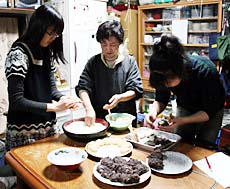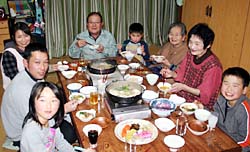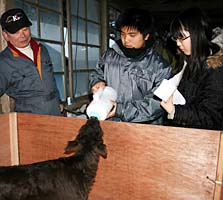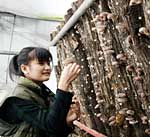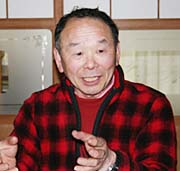The Strength of Rural Areas, Part 2
Warm-hearted people in a chilly town
| Junior writers stay at homes in the rural town of Sakugi in Miyoshi City |
In the previous issue of Peace Seeds, we introduced people who are engaged in self-sufficient lives by making use of the nature around them. In this issue, we share our personal experiences of February 11-12 when we tasted life in a rural area.
The area we visited is the town of Sakugi in the city of Miyoshi, located in the northern part of Hiroshima prefecture. Sakugi lies along the Gonokawa River, which flows through the mountainous Chugoku region. The town has a population of about 1,700 people, and 46% are over the age of 65.
We stayed with two local families, the family of Kunio Kuramoto, 69, and the family of Noriaki Sakane, 60. On their farms we tended cows and made rice cakes and a Japanese confection called "ohagi" (rice cakes covered with bean jam) for the first time. In Mr. Kuramoto's house, four generations live together and cheerfully sit around the table, eating and talking.
Our stay lasted only two days, but we came away feeling the warmth of people who live in contact with nature and invest themselves in forging their own lives.
Rural areas and urban areas. Recognizing the positive aspects of both would help us to build mutual respect and a caring coexistence.
| 縲 |
Making "ohagi" with homemade rice
The door to the kitchen opened and a warm, sweet smell wafted in the air. "First wash your hands," Yuri Sakane, 60, told us. And so began the making of "ohagi." We first took a wooden pestle and ground hot cooked rice, a mixture of glutinous and non-glutinous rice. This took about 20 minutes and it was pretty tough work. "We call this half-ground rice 'half-kill,'" Yuri said. The rice had been ground almost to a pulp. Then we picked up gobs of the half-ground rice with wet hands and molded each one into a flattened oval shape. We covered these with bean jam or soybean flour. Yuri's mother-in-law, Tsuyuka, 84, along with her three granddaughters, often made "ohagi" because Yuri is busy with her work as a nurse. They even sometimes eat "ohagi" for dinner. Our "ohagi" varied in size. Yuri nodded and said, "Your 'ohagi' looks delicious." The taste of "ohagi" includes the natural sweetness of both the soybean flour and the rice itself. (Yuumi Kimura, 14) Cheerful meals for a family of eight across four generations
Mr. Kuramoto's family needs 1.8 liters of rice a day. Kunio Kuramoto lives with his wife, his second daughter and her husband, three grandchildren, and his mother. His family consists of eight people spread over four generations. We had the opportunity to sit down for dinner with the entire family. Mr. Kuramoto takes pride in his home-grown rice. When I took in a mouthful, I tasted the sweetness of the rice on my tongue. Mr. Kuramoto explained proudly, "The quality of the soil here is very good and there's plenty of sunshine. I also fertilize the field with compost from our cows." He added, "The whole family takes part in planting and harvesting the rice." Mr. Kuramoto also enjoys taking photos, including photos of his grandchildren--Sachi, 11, Takumi, 9, and Toki, 7--helping with the farm work. I got the feeling that the delicious taste of the rice was due to the fact that all of them join in to produce it and then eat it together. I asked the three children, "Do you want to live here after you grow up?", and all of them answered, "Yes, I want to stay here." Mr. Kuramoto's mother, Matsuno, 92, smiled happily and patted her great-grandson Toki on the head. "My family is my treasure," she said. "Thanks to the enjoyable time I spend with them, I'm able to live a long life." (Shiori Kusuo, 18) Communicating with cows at feeding time
It's 7:30 in the morning. The temperature is 0 degrees Celsius. We're on our way to feed the cows. Due to last night's snowfall, the way from the house to the cattle barn has been frosted white. For 42 years, Noriaki Sakane has been tending to his cows in the morning and at night, both in the cold and in the heat. He breeds cows, and raises the calves. When a calf is eight months old, he sells it to another farmer. Those farmers then rear them as "Hiroshima beef cows." He now has 19 cows. When we entered the cattle barn, the cows approached the feeding troughs which faced the passageway. When a bail of hay was tossed into a trough, the cow set about eating. When a cow finished the hay in its own trough, it would thrust its head into another cow's trough for more. We fed a two-month-old calf with a feeding bottle. The calf clung hard to the bottle and quickly drank two liters of milk then continued sucking on the empty bottle. Mr. Sakane told the calf "All gone" by patting it on the head. "I feel happy when the cows welcome me home with their mooing," Mr. Sakane said. His work is hard, but we clearly felt his deep affection for his cows. (Shotaro Takata, 16) Making pizza in a stone oven surrounded by snow
In a valley surrounded by mountains, the snow fell steadily and the temperature had dropped below freezing. Smoke rose from the chimney of a small hut. Emitting that smoke was a stone oven built three years ago by Noriaki Sakane over a period of three months. Mr. Sakane built the hut, too. It can fit only 10 people. Warming ourselves by the oven's charcoal fire, we made pizza. We kneaded out the pizza dough then spread sliced onions, shiitake mushrooms, and cheese. After putting a pizza into the oven, it only takes a minute and a half for it to begin browning. We made pizzas one after the other. Although we used the same sort of ingredients we would use at home, we felt the taste was different. "Every pizza also holds the thoughts of the person who makes it," said Mr. Sakane's wife Yuri, 60. When we finally noticed, we realized that the 10 of us had made more than 30 pizzas. Our stomachs full, we left the hut. On the wintry rice fields, we enjoyed a snowball fight and riding on sleds. We made a big snowman and used charcoal for the eyes and the nose. "Everyone can feel free to enjoy themselves in nature," Mr. Sakane said. They find pleasure in the slow life that nature offers. (Saaya Teranishi, 14) Observing farming suitable for the Sakugi climate
Christmas roses of pink and pea green, about five centimeters across, are in bloom. Masanori Harada, 73, has been cultivating the flowers since the spring of 1999. Christmas roses prefer cold weather. "Sakugi is a suitable place for these flowers, since it's cold here in the winter," Mr. Harada said. He plants 4,000-5,000 roses in fields around his house and in greenhouses, and sells them at markets in the city of Hiroshima or at such sites as a road station, or a local resting area along the road, in the neighboring town of Funo in Miyoshi City.
When we entered one greenhouse, we saw a line of Japanese oak trees, each about one meter high. Growing on the trees were a lot of shiitake mushrooms. Shiitake fungus is inserted into holes in the trees and then cultivated. Toru Saiki, 59, grows the shiitake mushrooms. He uses some 20,000 Japanese oak trees that have been cut down in the mountains around Funo. In the old days, oak trees were used as charcoal. "I want to create employment opportunities by using local timber," he said. Ninety percent of the shiitake mushrooms consumed in Japan are cultivated through the process of planting the fungus in sawdust laced with nutrients. Mr. Saiki's method is different and the mushrooms that grow from his trees have a pleasant aroma and keep for a longer time. |
"A foundation for life" Interview with Noriaki Sakane
|
Noriaki Sakane, who serves as a leader of the community, says that the strength of rural areas lies in the foundation they offer for people to build their lives. Even as people grow older, there are many ways they can take part in the relaxing slow life of the countryside, such as doing farm work and attending community events. Mr. Sakane's name is well known in the community and he feels he has forged a strong identity. "A person in the countryside has the power of 100 people," he explained.
In Sakugi are found the majority of Broad-billed Rollers in Japan, an endangered bird that eats insects. The area offers a good environment for the lives of both birds and human beings.
The slow life is an easygoing life, but sometimes the tempo of life can become too slow for some. In addition, society's understanding of agricultural life is poor and farmers face a low level of income. With few opportunities for work, many young people leave these rural areas for larger cities.
Mr. Sakane makes an effort to tell local children: "Even if you move to a city, your hometown will always be Sakugi." Students at Sakugi Junior High School learn "kagura" (a traditional form of dance, with sacred music, originally performed at shrines) and children at Sakugi Elementary School study about the Broad-billed Roller.
In cities we can see the rapid aging of the population. Most of the elderly who live in housing developments don't know their neighbors well and have little chance to do things together with others. In Sakugi, on the other hand, the elderly still enjoy performing farm work and making contact with their neighbors. Mr. Sakane hopes that "Sakugi becomes a paradise for the elderly." He says, "For jobs, the city is a better place to be, but for a relaxing life, a rural area is better. If you like a fast tempo, you can choose to live in a city; if you hope for a relaxed style of communication, you can choose to live in a rural area." In his view, the lifestyle people choose depends on the individual.
Mr. Sakane believes that the coexistence of cities and rural areas, by creating links between them that bring satisfaction to everyone, is the important thing. We shouldn't get bogged down in the notion that "life in cities is good and life in rural areas is bad." (Sachiko Kitayama, 14)
|
Sakugi Junior High School is the only junior high in the town of Sakugi. (The principal of the school is Junji Sone and the school has an enrollment of 35 students.) We spoke with six second-year students on the school's student council about their thoughts on life in Sakugi.
| Members of the student council: | Kaname Eto, Yusaku Kan, Natsumi Hata, Eri Henmi, Takuto Motokuni, and Chiharu Morishima |
What do you feel are the advantages and disadvantages of a school of this size?
Natsumi: We can build close relationships with every person in the school.
Takuto: The school has a warm and welcoming atmosphere. When people transfer to our school, they easily make friends and quickly remember everyone's names.
Kaname: There are strong bonds between us because we've been together for more than ten years, ever since we were in preschool.
Eri: On the other hand, the only sports clubs at our school are track and field, volleyball, and table tennis. We grow up only knowing our own level within this small group, so I'm concerned about being na?ve to the wider world.
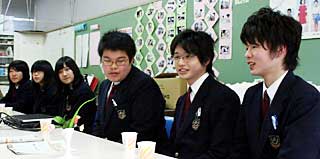 From left, Eri, Natsumi, Takuto, Kaname, and Yusaku talk about the good points of their school and the town of Sakugi.
|
What do you like about Sakugi? What do you dislike?
Kaname: My favorite place is the Josei waterfall. It was chosen one of the top 100 waterfalls in Japan. Sakugi has a lot of nice nature.
Eri: I like growing vegetables and rice.
Chiharu: I like the community events. I have no friends of the same age, but I can interact with the elderly and with students in lower grades and children in preschool.
Takuto: In winter, though, plowing snow is a daily job and it's really hard work. Getting too much snow can be dangerous. I help my grandfather with this.
Yusaku: I wish we had a convenience store nearby.
Would you like to live in Sakugi for a long time?
Chiharu: On one hand, I'd like to stay here, but on the other, I feel like I'd like to go somewhere else. People are warm and kind in Sakugi, so I think it's a good place to live and I really like it here. At the same time, I want to go to a bigger city and meet and talk with a variety of other people.
Kaname: I'd like to go somewhere else to study things I can't study in Sakugi. Then, if I got tired of living there, I'd come back.
Yusaku: I'd like to go to a city, too. It would be fun to meet different kinds of people. But when we performed "kagura" are school, the audience gave us a lot of praise and their words made me feel like I wanted to be a member of the "kagura" group in Sakugi.
Eri: I want to stay in Sakugi. When I was a small child, our neighbors were really warm. I want to be that kind of person, someone who children will think is warm.
How do you think the good points of Sakugi can be conveyed to others?
Chiharu: It would be good for us to remain true to ourselves. If we leave here for larger cities, we shouldn't let ourselves be influenced in a negative way by city life; we shouldn't forget the warmth and the kindness of Sakugi. That's what I'd like to convey to people in the city.
Natsumi: I'd like to bring my friends in the city back to Sakugi so they can see what a good place it is. If they thought about living here one day, that would be great.
Takuto: Sakugi doesn't need to be like larger cities. I want to encourage more and more people to visit Sakugi. I'd like them to enjoy their experience of the people and the nature of Sakugi.
